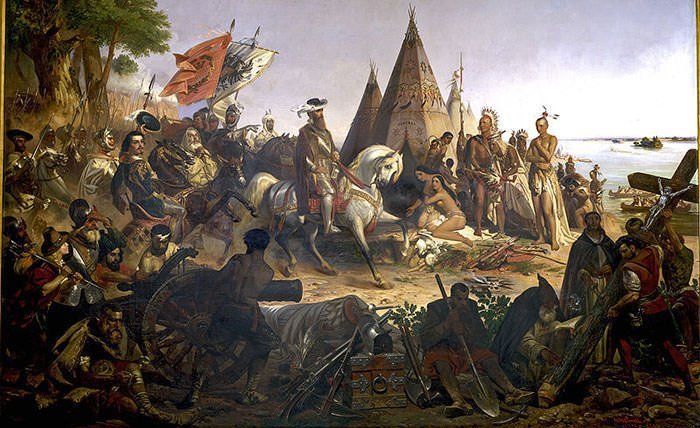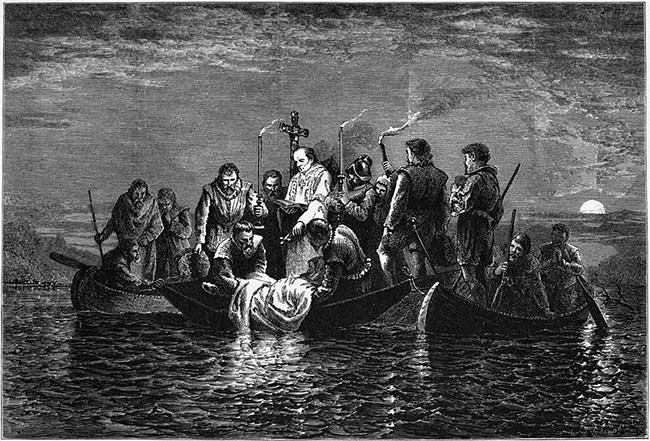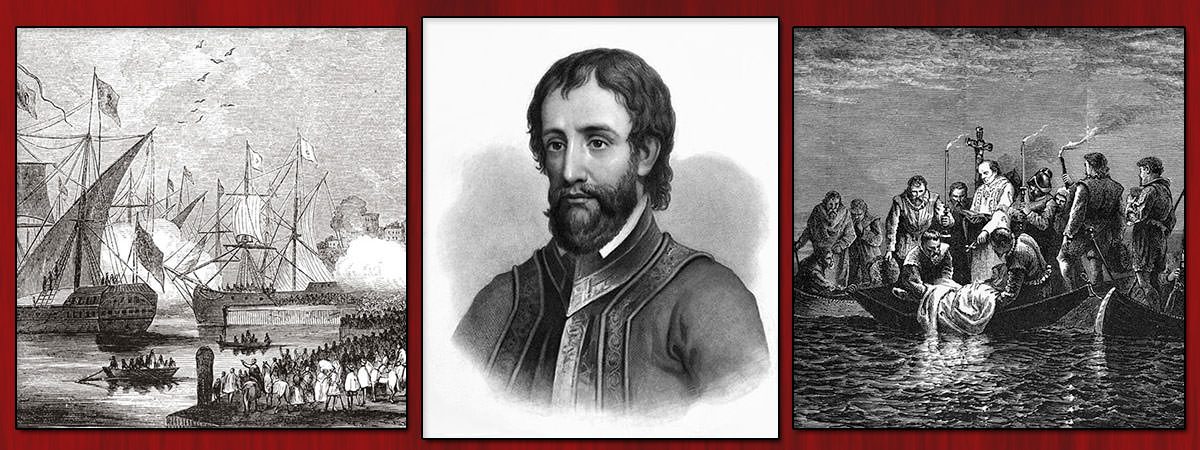Hernando de Soto was a 16th century Spanish explorer and conquistador who is famous for being the first person to lead an expedition deep into the territory of United States and discovering several areas which hadn’t been yet explored by Europeans. Know more about the role of Hernando de Soto in the conquest of Peru; his life, accomplishments and death; and his exploration of North America, through these 10 interesting facts.
#1 HIS PARENTS WANTED HIM TO BE A LAWYER
Hernando de Soto was born circa 1496 in Jerez de los Caballeros in the current Bajadoz province of western Spain. He was the second son of Francisco Mendez de Soto and his wife Leonor Arias Tinoco. Hidalgo is a nobleman without a hereditary title. De Soto’s parents were hidalgos but had little money. They wanted him to be a lawyer but De Soto dreamed of making a fortune in the New World from an early age. Soto had at least three siblings. His known siblings are a brother named Juan Mendez de Soto; and two sisters named Catalina de Soto and Maria de Soto.

#2 HIS FIRST EXPEDITION WAS TO THE WEST INDIES
In 1514, when Hernando de Soto was still in his teens, he left for Seville, which was the center of activities with the New World in Spain. There, due to his expertise as a horseman, he managed to get himself included on an expedition as captain of a cavalry exploration troop. The expedition was to the West Indies and was led by the first Governor of Panama, Pedro Arias Dávila.
#3 HE AMASSED A FORTUNE THROUGH SLAVE TRADING IN NICARAGUA
As Dávila’s lieutenant, Hernando de Soto was allowed to explore Central America in search of treasure and land. In Panama and later traveling to Nicaragua and Honduras, De Soto made his mark as an explorer and reaped high profits through skillful and bold trading with the natives. By 1530 he was the leading slave trader and one of the richest men in Nicaragua amassing a fortune from Dávila’s conquest of Panama and Nicaragua.

#4 HE PLAYED A MAJOR ROLE IN DEFEATING THE INCAS IN THE BATTLE OF CAJAMARCA
After the death of Dávila in 1531, De Soto left his estates in Nicaragua and joined Francisco Pizarro in the conquest of Peru which began the following year. De Soto had lent Pizarro two ships to investigate reports of gold in present day north-western Colombia. In return for the use of his ships, Pizarro named De Soto his chief lieutenant during the conquest. De Soto, as the expedition’s captain of horse, played a leading role in Spaniards defeating the Incas in the Battle of Cajamarca and capturing their emperor Atahualpa.

#5 HE MADE AN ENORMOUS FORTUNE DURING THE SPANISH CONQUEST OF THE INCA EMPIRE
While Atahualpa was held captive by Pizarro to control the Inca Empire, for political reasons De Soto developed friendly relations with the emperor, who gave him several lavish gifts. On 26 July 1533, Pizarro executed Atahualpa even though his subjects had raised an enormous ransom in gold in order to ensure his release. After executing Atahualpa, the Spanish headed to Cuzco, the capital of the Inca Empire. Here too De Soto played a leading role in defeating the Incas. Dissatisfied with Pizarro’s leadership, De Soto returned to Spain in 1536. He was among the wealthiest of the returning conquistadors, his share including riches from Atahualpa’s camp, his ransom, and the plunder from Cuzco.

#6 HERNANDO DE SOTO WAS MADE GOVERNOR OF CUBA
On his return to Spain, De Soto was admitted into the prestigious Order of Santiago. In 1537, De Soto married Inés de Bobadilla (or Isabel de Bobadilla), the daughter of Pedro Arias Dávila. The same year he sought special permission to conquer Ecuador, with special rights to the Amazon River basin. Instead he was made governor of Cuba and commissioned by the Spanish crown to conquer what is now Florida.

#7 HIS FAMOUS EXPEDITION LANDED AT TAMPA BAY IN MAY 1539
On 6 April 1538, Hernando de Soto departed for North America from the port of Sanlúcar de Barrameda. 10 ships and 700 men were under his command. After a stop in Cuba, the expedition landed in May 1539 at Tampa Bay, a large natural harbor and estuary connected to the Gulf of Mexico on the west central coast of Florida. De Soto’s party encountered a man named Juan Ortiz, a survivor from an earlier expedition who had lived with the natives for 12 years. He became their interpreter as they marched inwards in search of gold, a passage to China and what they could term an advanced civilization.

#8 HIS EXPEDITION FOUGHT ONE OF THE BLOODIEST BATTLES WITH NORTH AMERICAN NATIVES
De Soto and his men set up camp for the winter at the small Indian village of Apalache near present-day Tallahassee. In spring the expedition moved through modern day Georgia. It was guided by natives whom they abducted along the way. Though they didn’t find the gold they were looking for, the female chief of the chiefdom Cofitachequi turned over the pearls of her tribe to them. During their return journey towards Mobile Bay, the expedition became involved in a bloody battle with the residents of Mabila, a fortified city in southern Alabama. Though they decimated the natives, the Spanish lost more than 200 men and many were injured. They also lost most of their equipment and all their pearls.

#9 HE WAS THE FIRST RECORDED EUROPEAN TO REACH THE MISSISSIPPI RIVER
On May 8, 1541, De Soto’s troops became the first Europeans to reach the Mississippi River. They crossed the river and headed into Arkansas and Louisiana. The same year, they became the first Europeans to see in Arkansas what is now known as Hot Springs. In early 1542, De Soto decided to explore more and turned back towards Mississippi. He was struck by fever and died on May 21, 1542 in Louisiana. It is said that his comrades wrapped his body in cloaks packed with sand and cast it into Mississippi. The expedition was then led by Luis de Moscoso, whom De Soto appointed his successor, and they reached Mexico in 1543.

#10 HIS EXPEDITION HAD SEVERAL MAJOR REPERCUSSIONS
Hernando de Soto’s expedition had several major consequences. It contributed in making the relationship between Europeans and North American tribes more hostile. It played its part in the process of the Columbian Exchange with the most prominent effect being the decline of indigenous population due to the diseases brought by Europeans. Also the records of the expedition contributed greatly to European knowledge about the geography, biology, and ethnology of the New World. Hernando de Soto is considered one of the most important Spanish conquistadors and many parks, towns, counties, and institutions have been named after him in the United States.

DE SOTO’S EXPEDITION AFTER HIS DEATH
After De Soto’s death, his expedition ran into difficulty encountering hostile tribes during their return journey. Natives followed their boats in canoes, shooting arrows at the soldiers for days on end. With no offensive weapons left with them, they relied on armor and sleeping mats to block the arrows. After suffering several casualties they were able to reach the safety of the Spanish frontier town of Pánuco. 311 of the initial 700 participants managed to survive till the end. Most of them stayed in the New World, settling in Mexico, Peru, Cuba and other Spanish colonies.

